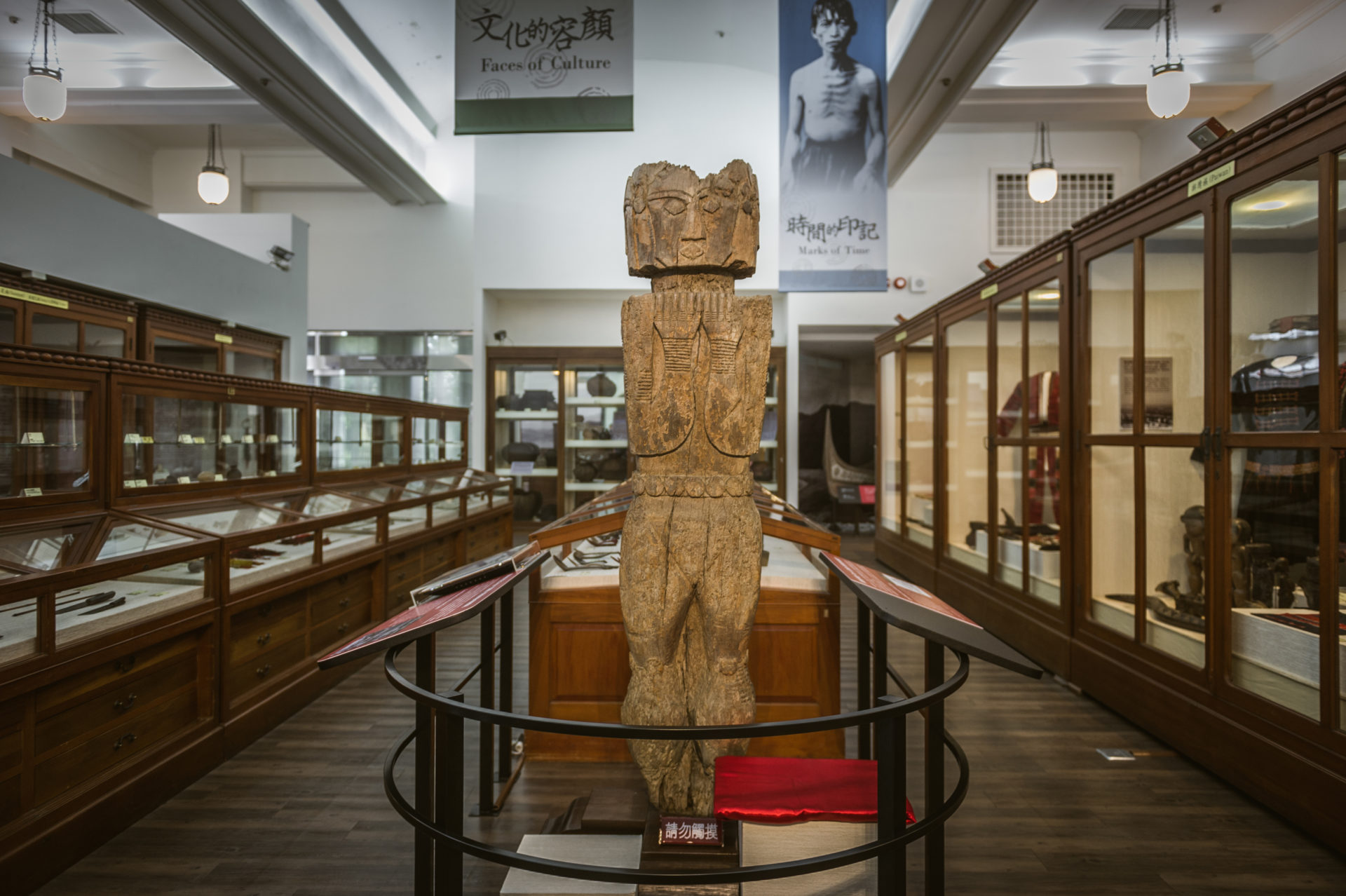【Museums Link Asia-Pacific】World’s First National Treasure Wedding – How Museums and Tribes are Connected through Artefacts
The four-sided wooden ancestral post at NTU Museum of Anthropology (photo by Fu Yu-cheng, Smalleyes Photography)
Author: Wu Chia-Cheng (MA of Graduate Institute of Anthropology, National Taiwan University)
On September 12 of 2015, NTU Museum of Anthropology and the Paiwan Kaviyangan tribe joined hands and organized an unprecedented wedding for a national artefact. NTU President represented the museum and married the “four-sided wooden ancestral post” of the tribe. During the process, Paiwan people retrieved their memories of the artefact and were able to balance their power against NTU and even the state through their cultural logic embedded in weddings. After the wedding, the two “in-laws” continue to engage and interact, responding to the public’s concern regarding the repatriation of the artefact and charting a new path for contemporary relations between the museum and the tribe.
Keywords: national treasure wedding, cultural logic, repatriation of artefacts, cultural revitalization, museum of anthropology
An unprecedented national treasure wedding
The staff of NTU Museum of Anthropology never thought that one day they would organize a wedding for their museum artefact.
At the end of 2014, with arrangements made by Curator Hu Jia-Yu, the staff went to the Kaviyangan tribe in Taiwu Township, Pingtung County to ask if the tribe agreed to allow the museum to apply the “four-sided wooden ancestral post from the house of Chief Zingrur, Kaviyangan Paiwan”, one of the collections of the museum, as a national treasure. If it is to be listed as the highest category of antiquities under the Cultural Heritage Preservation Act, preserving and moving the ancestral post would be regulated under strict laws. Therefore, Curator Hu found it necessary to consult the intention of the tribe. In addition, the visit meant to collect more memories and stories the tribe had with the artefact.
However, this ancestral post was brought to the Museum of Anthropology (then Ethnology Collection Room) by the Japanese as early as 1932 and most people in the Kaviyangan tribe when the museum initially contacted were unfamiliar with it. According to research and oral sharing of local seniors, this wooden post was taken from Chief Zingrur’s house. It was the side post that helped support the structure. The female ancestor that established the Kaviyangan tribe was carved on the post and the statue is closely related to their belief in ancestral spirits. Zingrur’s house was also listed as one of the two historical sites of indigenous people by the Government-General of Taiwan because of its unique architectural features and cultural significance. However, Japanese colonizers forbade the performing of traditional rituals and thus the belief in ancestral spirits gradually declined. Plus, Kaviyangan moved twice between the 1940s and the 1950s, and eventually moved from their ancestral land Kaviyangan (where the tribe got its name) to the current site at the foot of the mountains. There was little time for rituals during those periods, causing the traditional belief to further decline and a memory gap was created towards the old tribe and the house of the chief.
Therefore, when the museum first had a discussion with the tribe, there were rarely any people that remembered this ancestral post. Fortunately, one senior from the Zingrur family still remembered the life at the old house and identified that the ancestor carved on the post is supposed to be Muakai, the female founder of the tribe. Features such as light circular carvings of the knees and the six fingers carved on the post were thus connected with their oral history, and a lost story was recovered.
The Kaviyangan people, however, felt conflicted since they had only just reconnected with their ancestral post but it was now listed as a national treasure. One person in the tribe mentioned that he felt both happy and reluctant and that the tribe’s debate over the ancestry of Muakai was similar to the process of discussing bride token before a traditional Paiwan wedding. Therefore, an idea suddenly came to them: what if they requested NTU to host a wedding and marry the ancestral post? This would not only show the nobility and value of Muakai, but would also allow them to form an alliance with NTU, which is helpful for future interaction. Surprisingly, the museum agreed to this idea and the level was even elevated in the planning afterwards. In the end, it was decided that Former President Yang Pan-Chyr would represent the university and marry the ancestral post. After the national treasure review was passed on March 25 of 2015, the Kaviyangan tribe and the museum began the busy process of planning a wedding.
The cultural logic behind the wedding
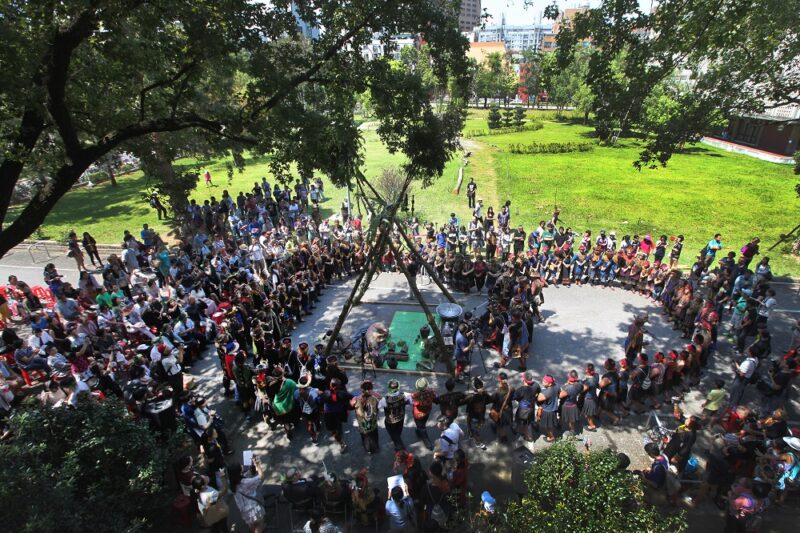
It was a sunny day in late summer, and this unprecedented national treasure wedding was grandly hosted at the square in front of NTU Museum of Anthropology. In addition to people from the tribe and university staff, many scholars and NTU faculty members and students also participated the event. Hundreds of people surrounded the swing that symbolizes the purity of the bride. Amid the singing of tribal youth and women, the Zingrur princess sat on the sedan chair and was slowly carried to the venue. Representatives from the tribe emphasized their reluctance of the post staying in NTU and said that even though questions were raised by some villagers and other tribes during the process, the tribe hoped that through the wedding, more people would get to know the artefact and the Kaviyangan tribe and that NTU should take good care of Muakai. There was a part of the wedding when the family of the bride gave NTU a hard time, showing that it was not easy to get Muakai. This not only conforms to the Paiwan custom of demonstrating the high status of the bride when marrying off their daughters, but also shows the agency of the tribe when working with museums.
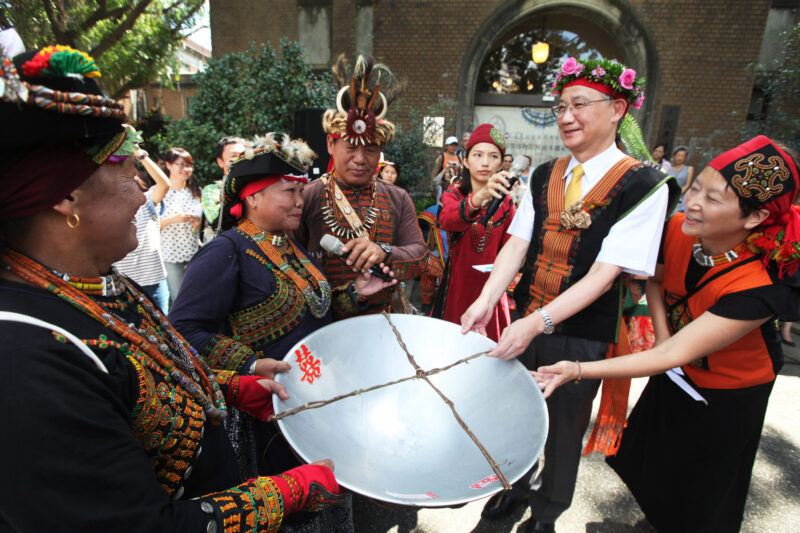
This event, indeed, created a new model for museums to interact with tribes; however, conflicts were still provoked due to the unequal power relations between the two parties when designating the artefact as a national treasure. Such inequality, resulting from the reign of the state and modernity, has its origin in the colonization period. When an object is involved in these existing unequal structures, such inequality may be further strengthened because of the object’s feature. For instance, it is not easy to move the ancestral post, especially when it has become a national treasure; therefore, although by practice, the wedding should be held in the tribe, it was still held in NTU eventually. And this was one of the issues opponents had against the wedding. However, the energy of the object may also shake existing frameworks. For instance, the female ancestor Muakai, carved on the post, happened to conform to the concept of marriage for the Han Chinese. Therefore, it was easy, from the university’s perspective, to imagine having the ancestral post thus included inside the campus. At the same time, marrying off a princess is the most formal, high-profile wedding in the Paiwan culture, and therefore, the wedding was able to be held, and the tribe had a higher stance to “check” if the university is qualified to marry Muakai.
The wedding was not just a duplication of traditions for the tribe in order to produce an imagined collective identity of Kaviyangan. The tribe also demonstrated their agency to people outside the tribe through the wedding, showing that the tribe voluntarily left the ancestral post in the museum. The wedding, at the same, is also a ritual that helped persuade people inside the tribe, allowing the tribe to see that the Zingrur family had the equal capability to NTU and was even able to have the Minister of Culture as a witness of the wedding. People that joined the wedding would further recognize the significance of their chief. Therefore, this wedding is a double discourse to both people inside and outside the tribe. It demonstrates the attempt of the Zingrur family balancing against NTU and even the Ministry of Culture. Although faced with many obstacles, they were able to fight against contemporary governance through their own culture and custom. The museum and the Ministry of Culture also got to understand the intention of the Kaviyangan tribe during the multiple negotiations and helped facilitate the wedding. Indeed, this wedding is a breakthrough in the collaboration between the museum and the tribe. However, if we are to look at the original political connotation of a traditional Kaviyangan wedding, this national treasure wedding is actually an “old method, new attempt” that combines Kaviyangan’s existing cultural logic and contemporary power agent.
The challenge of sustaining the marriage
What comes after getting married? How should the museum and the tribe continue in developing their alliance? The test is only beginning after the grand wedding.
After the wedding, both the museum and the Kaviyangan tribe tried to explore ways to continue their connection. A year went by and the most active organization in promoting cultural revitalization in the Kaviyangan tribe, the Youth Association, came up with a fresh idea. In the summer of 2017, 18-year-old Kaviyangan youth visited NTU, sent out invitation cards of the tribe’s Harvest Festival, and sang the ancient anthem of the Zingrur family in front of the Muakai ancestral post as one of the challenges for their coming-of-age ceremony. This series of activities show that the Youth Association is combining the existing practice of sending out invitation cards and coming-of-age challenges with their new relationship with NTU. The “invitation”, thus, is not just a courtesy but symbolizes that the Kaviyangan tribe include NTU as an extension of the tribe after the wedding. NTU became an important member that the tribe needs to invite in person. Besides, the regular visit to the ancestral post also allows Kaviyangan youth to have an opportunity to meet and get to know Muakai face to face. Therefore, the ancestral post is no longer just a collection in a distant museum but takes an essential role in Kaviyangan’s cultural revitalization and its continuous interaction with NTU. Also, every time when NTU hosts an activity or a seminar related to museums or cultural heritage, the Kaviyangan tribe often sends representatives to participate. Such regular interaction can not only sustain the relationship, but also help explain the complex emotions of the tribe for hosting the wedding and respond to the questioning of “why the Kaviyangan tribe did not take back its artefact”.
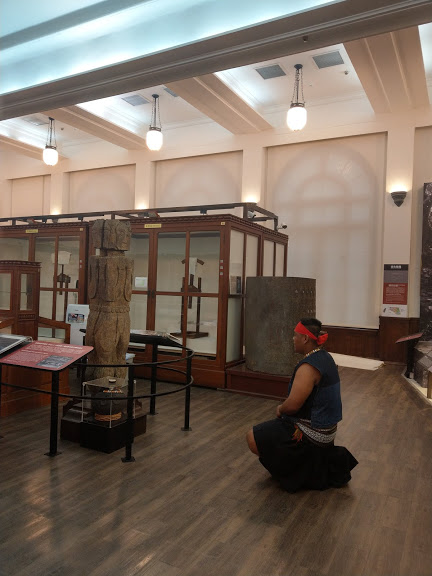
As for NTU, after the wedding, the NTU Museum of Anthropology also sends representatives to precipitate tribal rituals and activities. It also arranges budget and invites the tribe to participate when activities of relevant topics are held. In addition, since 2017, students from the Department of Anthropology have been participating in the Harvest Festival of the tribe. They go to the Kaviyangan tribe during the preparation period and work alongside the Youth Association, practicing the songs and dances for the ritual. They are thus able to get to know their “in-laws” and build bonds with the locals. Students would normally re-visit the tribe after the festival. They are not only the NTU relatives of the tribe, but also members of the tribe recognized by the community.
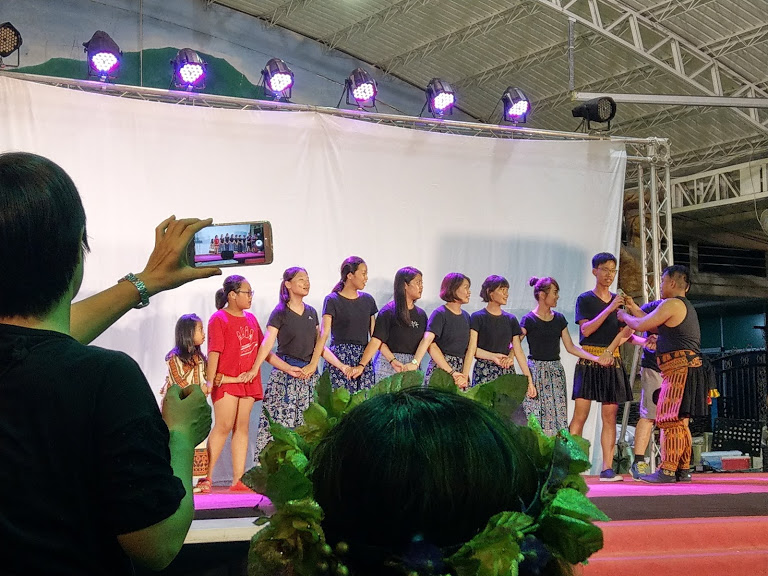
If we look closely at the process of the museum and the tribe “becoming in-laws”. It was indeed a bit clumsy in the beginning; in fact, one may even argue that it is a conspiracy in which the museum and the tribe have different plans in mind. However, with the close interaction that follows, they were gradually touched by each other and were willing to be devoted to sustaining the relationship. This relationship developed because of ancestral post Muakai shows not only actual but also continuous affections from both sides.
References:
- Facebook fan page: NTU Museum of Anthropology
- 小花電影有限公司(2018)。Muakai的跨世紀婚禮(光碟)。文化部文化資產局發行。
- 文化部文化資產局(2015)。排灣族佳平舊社金祿勒頭目家四面木雕祖靈柱(na paiwan a kemasi kaviyangan na lja zingrur a pararulj)。國家文化資產網。
- 吳昭潔(2017)。〈從臺大國寶婚禮談博物館與原生社群互動的可能性〉。《史物論壇》22:179-200。
- 莊德才(2017)。〈國寶祖靈柱的婚禮〉。《刻劃排灣學:文化的持續與變遷》。Tjuku Ruljigaljig編,頁227-268。排灣學資料彙編。第一輯。臺北:耶魯。

